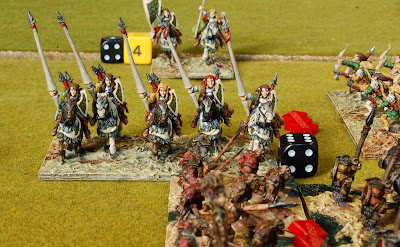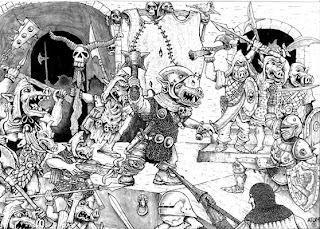This One's Split
This One's Split (*) is a work-in-progress set of wargames rules for large fantasy battles. The rules are heavily inspired by Too Fat Lardies rulesets like Ain't Been Shot Mum and La Feu Sacré (LFS), in particular where the command and control system is concerned.
Overall aims and goals
Scale
Approximate ground scale of 1" = 25m, and approximate time scale of 1 turn = 15 minutes.
Units and Individuals
In this game we've chosen to represent both formed troops (units) and those individuals that play a major role on the battlefield; commanders, heroes and mages.
Individuals all share a set of attributes which describes how well they can command troops (similar to LFS), their skill at personal combat, and various attributes regarding to the use of magic. Further attributes will be available to personalize the various characters (bloodthirsty, coward, bold, etc.)
Troops are divided according to their formation, weaponry, armour, and further attributes such as 'shock' troops. Each base represents a unit of a certain number of troops, depending on their formation:
Racial attributes will be in place, making tangible differences between the races that add character and not just combat strength. For special troop types such as behemoths, giants, swarms and such, this will obviously be different.
A base size of 8x4cm is assumed, but others (e.g. 6x3cm, multiple DBM bases, etc) can be freely used, as the base size is not relevant to the combat mechanism.
Blinds
Initially only blinds are deployed. Then, as the opposition is scouted out, the actual troops are deployed onto each of those blinds. This allows for a degree of uncertainty at the start of the battle, until the true composition and location of the enemy is found out.
Command and Control
Individuals have the ability to activate units and thus get them to 'do' things. Commanders can do this for a number of units, that fall within their command. Other individuals can only do this by attaching themselves to a unit and leading by example.
The sequence in which the various commanders/individuals are activated is a chit/card-based system. The amount of troops they can activate/the complexity of the tasks they can have them execute is determined by the skill of the individual.
As we want to encourage players to use formations of multiple bases, it is possible to activate more troops within a formation than to activate all these units individually.
Combat mechanisms
Combat mechanisms are in place for both ranged and close combat. Ranged combat results in attrition of the hostile troops (no figures are removed, but casualties are marked either on table or on paper), with the potential of morale failure.
To properly see the opponent off the field, there is nothing like naked steel. Close combat is carried out on a base vs base mechanism, taking into account factors such as the formation, morale, protection, weaponry and tactical circumstances. A die roll then determines who is the victor and who is the loser - and how bad the loss is. Casualties are also determined as a result.
In special cases (troops suffering heavily from missile fire prior to combat, terror-inspiring opponents and such), a simple 'flinch' or morale test is carried out to determine if a base already drops in morale prior to combat.
Magic
Mages on the battle field are the cream of the cream - or they would simply have no effect. They're not your average mage that throws fireballs, makes rabbits disappears etc. Battlefield mages are scarce, only a few for a large battle.
These mages gather magical power to be able to affect the battle, and need to take critical decisions on when to use it. Expect a mage to influence the battle on one or two critical moments - not each and every turn.
Mages are differentiated by the amount of magical energy they can gather, the amount of control they have, and the spells that they may have prepared. If a mage goes in over his head and gathers more magical energy than he can control, bad things(tm) happen - so it is always a balance between getting the biggest 'oomph' and not letting things grow out of control.
STATUS
(*) "Pass me another elf, this one's split - General Ashnak - Orc Commander in Mary Gentle's"Grunts"
Overall aims and goals
- Battles that 'feel' right
- Racial differences at both unit and command level
- Commanders that command rather than hit stuff (primarily), focus on command and control
- Magic system that adds colour, but doesn't bog down
- Different possible tactics reflecting different races
- Fun gameplay regardless of race played
- Solid mechanisms for special troop types (e.g. flyers)
Scale
Approximate ground scale of 1" = 25m, and approximate time scale of 1 turn = 15 minutes.
Units and Individuals
In this game we've chosen to represent both formed troops (units) and those individuals that play a major role on the battlefield; commanders, heroes and mages.
Individuals all share a set of attributes which describes how well they can command troops (similar to LFS), their skill at personal combat, and various attributes regarding to the use of magic. Further attributes will be available to personalize the various characters (bloodthirsty, coward, bold, etc.)
Troops are divided according to their formation, weaponry, armour, and further attributes such as 'shock' troops. Each base represents a unit of a certain number of troops, depending on their formation:
- Close order: 800 infantry or 500 cavalry
- Open order: 600 infantry or 400 cavalry
- Skirmish order: 400 infantry or 300 cavalry
Racial attributes will be in place, making tangible differences between the races that add character and not just combat strength. For special troop types such as behemoths, giants, swarms and such, this will obviously be different.
A base size of 8x4cm is assumed, but others (e.g. 6x3cm, multiple DBM bases, etc) can be freely used, as the base size is not relevant to the combat mechanism.
Blinds
Initially only blinds are deployed. Then, as the opposition is scouted out, the actual troops are deployed onto each of those blinds. This allows for a degree of uncertainty at the start of the battle, until the true composition and location of the enemy is found out.
Command and Control
Individuals have the ability to activate units and thus get them to 'do' things. Commanders can do this for a number of units, that fall within their command. Other individuals can only do this by attaching themselves to a unit and leading by example.
The sequence in which the various commanders/individuals are activated is a chit/card-based system. The amount of troops they can activate/the complexity of the tasks they can have them execute is determined by the skill of the individual.
As we want to encourage players to use formations of multiple bases, it is possible to activate more troops within a formation than to activate all these units individually.
Combat mechanisms
Combat mechanisms are in place for both ranged and close combat. Ranged combat results in attrition of the hostile troops (no figures are removed, but casualties are marked either on table or on paper), with the potential of morale failure.
To properly see the opponent off the field, there is nothing like naked steel. Close combat is carried out on a base vs base mechanism, taking into account factors such as the formation, morale, protection, weaponry and tactical circumstances. A die roll then determines who is the victor and who is the loser - and how bad the loss is. Casualties are also determined as a result.
In special cases (troops suffering heavily from missile fire prior to combat, terror-inspiring opponents and such), a simple 'flinch' or morale test is carried out to determine if a base already drops in morale prior to combat.
Magic
Mages on the battle field are the cream of the cream - or they would simply have no effect. They're not your average mage that throws fireballs, makes rabbits disappears etc. Battlefield mages are scarce, only a few for a large battle.
These mages gather magical power to be able to affect the battle, and need to take critical decisions on when to use it. Expect a mage to influence the battle on one or two critical moments - not each and every turn.
Mages are differentiated by the amount of magical energy they can gather, the amount of control they have, and the spells that they may have prepared. If a mage goes in over his head and gathers more magical energy than he can control, bad things(tm) happen - so it is always a balance between getting the biggest 'oomph' and not letting things grow out of control.
STATUS
- Command and control mechanism is in place
- Basic combat and movement mechanisms are in place. Many refinements however still need writing down
- Racial and individual attributes are being fleshed out
- A first start has been made on the magic system. Spells/effects and such still need to be dreamed up.
- Rules for a plethora of special troop types still need to be thought up, in particular for flying troops. Combat mechanisms for giants and behemoths are already in place.
- Playtesting will be needed to verify all the factors and whether they scale appropriately
(*) "Pass me another elf, this one's split - General Ashnak - Orc Commander in Mary Gentle's"Grunts"




Comments
Post a Comment